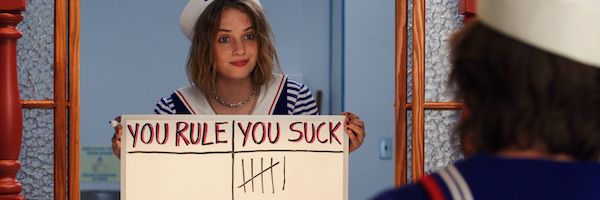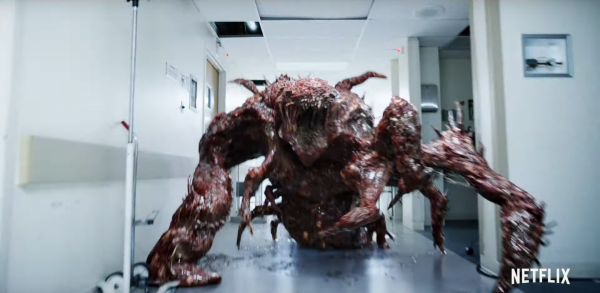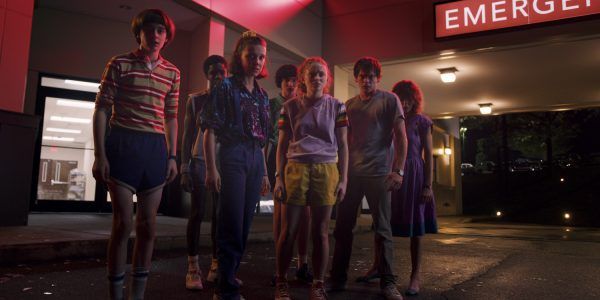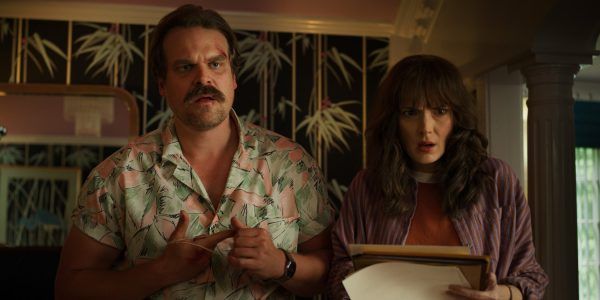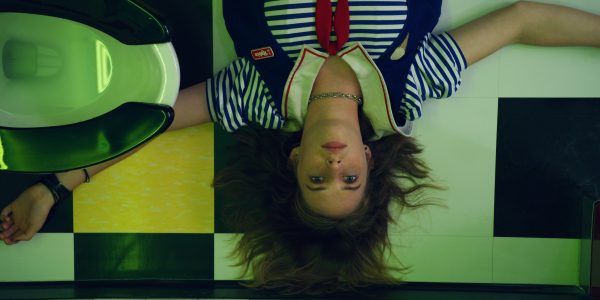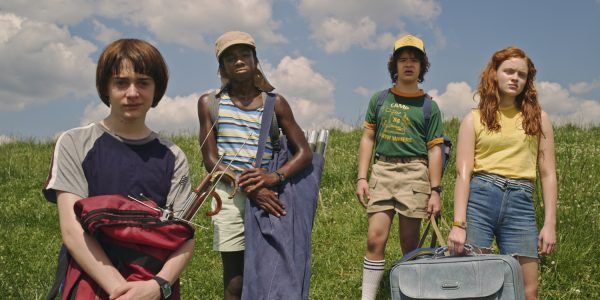*Spoilers ahoy! Turn back if you haven't watched all of Stranger Things 3*
One of my favorite tidbits about Jordan Peele's Get Out is that it was inspired by that amazing Eddie Murphy bit about a black family in a haunted house: "It's very simple. There's a ghost in the house, get the fuck out." It's a joke, but it's also part of the tension that makes any truly great horror like Get Out an almost impossible task; that underlying question of how many murders, door slams, or interdimensional monsters it takes before the characters just leave? And what does a storyteller do to stop them from leaving, repeatedly, while still keeping things interesting? I was thinking about this storytelling tight rope when, after three seasons, Stranger Things finally got the fuck out of the house. Or, more accurately, out of Hawkins, Indiana, where a rift between dimensions has been opening and closing for two years now, leaving massive monsters free to infiltrate our world and start personal vendettas with school-children. In the most emotionally devastating scene the Duffer Brothers have ever pulled off, season 3 closed on the Byers family, with Eleven (Millie Bobby Brown) in tow, saying their goodbyes to home, to youth, to innocence, and quite literally to the friends they made along the way. Tied together with a voice-over from David Harbour's recently vaporized(?) Sherriff Jim Hopper, it felt like both a satisfying ending and a new beginning for the show. "Keep on growing up, kid. Don't let me stop you," Hopper writes to El, which doubles perfectly as a coda to a Stranger Things that, at long last, was free to grow up.
Right up until it wasn't. If you stuck around for season 3's Marvel-esque mid-credits scene, you saw that the Russian military is not only still interested in the Upside-Down but they've also captured a Demogorgon, the monstrous Big Bad that terrorized Hawkins in season 1. What's more, the "American" locked up in a holding cell is most likely a very-much-alive Hopper. Apparently, the idea of things getting stranger means things that stay exactly the same. In horror terms, it's getting the fuck out of the Overlook and checking in to the Dolphin Hotel.
Make no mistake, the third season of Stranger Things is an absolute breezy delight, start to finish. It's a warm summer nights' ride on a carnival roller coaster. It's an indulgent meal of candy and cakes. It's a perfectly paced 4th of July fireworks show, all lights, color, and sound. But man, those delights are familiar delights at this point. Imagine riding the same roller-coaster three times in a row; having candy for dinner three meals in a row; watching the same fireworks display three nights in a row. That's Stranger Things, a show that was supposed to be a one-and-done season until it became a phenomenon and is clearly not quite sure how to keep sustaining itself.
Season 3 once again opens the divide between Earth and the bizarro-land of the Upside-Down. It once again uses the Mind-Flayer as an antagonist, who once again possesses a Hawkins resident to once again try and break out into our world. The formula might not be as noticeable if the Mind-Flayer and his Lovecraftian homeworld were a dynamic presence, but three seasons on and the Big Bad is just a personality-free bogeyman. He's gigantic and he likes houses to be freezing cold. So what? That's how I describe my dad. It's an odd creative choice to create an entire alternate dimension but only show the same two presences again and again, neither of which has ever expressed an actual motivation beyond aaaarrrgghhhh. The concept of a dark mirror universe—populated, assumedly, by dark mirror people—is so darn interesting, and the show has dived into the shallowest parts possible for three seasons.
That's the thing. The show itself has clearly gotten bigger—as has the young cast, who are all like nine feet tall now—but it's uncertain whether the Duffers have grown past that season 1 set-up as storytellers or filmmakers. There's a scene in season 3's penultimate episode, "The Bite", in which our main crew of heroes is assembled in Hopper's cabin as the Mind-Flayer approaches; the camera spins around them, back to back, as they respond to the ominous pounding on the walls and ceiling. It's exciting, unless you notice that it's nearly identical to a moment in the penultimate episode of season 2, "The Mind Flayer", in which our main crew of heroes is assembled in the Byers' house as the Dema-Dogs approach; the camera spins around them, back to back, as they respond to the ominous pounding on the walls and ceilings. Both scenes were written and directed by the Duffers, and both are practically identical in everything from blocking, to sound design, to the overall execution. It's odd to see a show that was basically built on homages to the 80s become an homage to itself.
Of course, the easy rebuttal to all this is that we've already seen Stranger Things do something different. It was called "The Lost Sister", a colossal creative misfire that tried to act as a backdoor pilot but ended up being a pilot who is legally blind and flies straight into the side of a mountain. But the problem with Eleven's standalone punk-rock odyssey wasn't that the story changed, it was that the people changed. Beneath the overwhelming 80s nostalgia and Easter Egg hunts, the component that skyrocketed Stranger Things into pop culture royalty is this shockingly endearing cast. I'll never forget the moment in 2016 when Netflix offered me Stranger Things interviews and I opted for freaking Matthew Modine, unaware that this young, insanely talented cast—plus a relatively unknown David Harbour and Winona Ryder in her first major role in years—would be so damn charming, breathing new life into the type of bike-riding, kids-doing-adventures roles we've seen on-screen for decades. The most interesting arcs on the show are small, personal ones. Steve Harrington's (Joe Keery) journey from bully to babysitter. Hopper and El's unorthodox father-daughter relationship. Even newcomer Robin—played by Maya Hawke in a true breakout performance—scores one of the most emotional moments of season 3 just by coming out to Steve on a bathroom floor.
These characters are a strong, sturdy center; they're the constant. Put them together in the middle of the action and you almost can't go wrong. So why not surround them with something different? It's the only way for this show to stop referencing a neverending story and actually become one.

